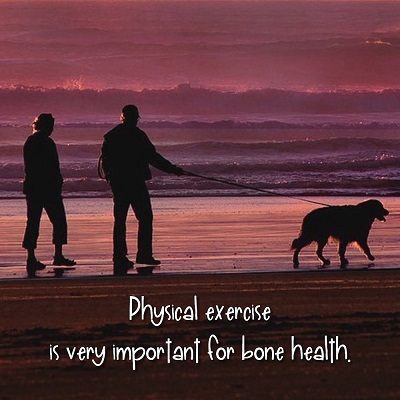 Physical exercise is very important for bone health. Any form of physical activity helps to keep the bones healthier, and aids in muscle strength, flexibility, balance, and coordination.
Physical exercise is very important for bone health. Any form of physical activity helps to keep the bones healthier, and aids in muscle strength, flexibility, balance, and coordination.
Bone density or the amount of bone minerals and calcium found in our bones can be measured with a BMD (bone mineral density) test. A BMD test can effectively determine a person’s bone health, risks of breaking bones, and osteoporosis. If the bone mass is low, but not low enough to qualify as ‘osteoporosis,’ it is known as osteopenia.
Whether a person has osteoporosis, osteopenia, or is healthy, physical exercises can further help keep the bones stronger, reduce the risk of breaking bones, and prevent accidents, injuries, or the likelihood of a bad fall.
These are helpful physical exercises that could help in building and maintaining strong bones:
Weight-Bearing Exercises
Weight-bearing exercises are either high-impact or low-impact. These exercises are usually composed of activities that enable you to move against gravity while keeping an upright position.
High-impact weight-bearing exercises can effectively help in keeping the bones stronger. Some examples of high-impact weight-bearing exercises include hiking, climbing the stairs, playing tennis, high-impact aerobics, running, jogging, and even dancing. Although high-impact exercises help to build stronger bones, people with osteoporosis or those at risk of breaking a bone should avoid such activities, or at least consult their physician first for the best advice.
Low-impact weight-bearing exercises on the other hand may be a safer alternative for people who are at risk of breaking their bones or have conditions like osteoporosis. They aid in building stronger bones but are not as strenuous as high-impact weight-bearing exercises.
A few examples of low-impact weight-bearing exercises are low-impact aerobics, fast walking on a treadmill, stair-step machines, brisk walking, and elliptical training machines.
Muscle-Strengthening Exercises (Resistance Training)
Muscle-strengthening activities or exercises are another type of exercise that is recommended for maintaining stronger bones and improving bone density. These exercises enable you to move your body or your weight against gravity. Basically, it makes the muscles work against a force, causing microscopic damage to the muscle cells. These tears are then quickly repaired by the body, making the muscle regenerate until it grows stronger than it once was.
The process of breaking down the muscle fiber is known as “catabolism,” whereas the repair process is called “anabolism.” Anabolic also means “to grow” – the exact thing that happens when the muscle fibers are broken down through resistance training exercises and experience a rapid re-growth.
Muscle-strengthening exercises are also known as weight training or strength training. They effectively increase muscle strength. It is all about using resistance to muscular contraction, in order to build strength, endurance, and size of the skeletal muscles.
But more than just the muscles, studies also show that they can help regenerate the bones, even for elderly people. It even helps improve joint function, tendon, and ligament strength too, on top of improving bone density and muscle strength.
Some examples of these types of exercises include:
- Weight lifting and the use of free weights such as kettlebells, barbells, and dumbbells.
- Use of weight machines or any devices that have adjustable seats with handles that are attached to weights or hydraulics.
- Use of resistance bands or elastic exercise bands. These provide continuous resistance when stretched or throughout a movement. They’re handy and highly versatile.
- Standing, simply using your own body weight. Walking is a great way to stand tall and exercise.
- Push-ups and squats. Again, using your own body weight.
- Pilates, yoga, and Tai chi.
Both weight-bearing exercises and resistance training exercises are highly recommended for the development of strong bones. Some of them are also very practical to do, without the need for a guide or the use of machines, such as walking, jogging, climbing the stairs, push-ups and squats.
Most exercises are safe, as long as they’re conducted within the right parameters. However, people with existing health conditions such as heart problems, high blood pressure, or even osteoporosis, should consult their health care providers first before performing these exercises, especially if it involves high-impact weight-bearing workouts.
Listen to your body and try to get moving on a daily basis so your body will get used to it. A good workout routine will bring specific benefits to you in helping you build stronger bones, but it’ll also contribute to a greater sense of wellbeing overall.






